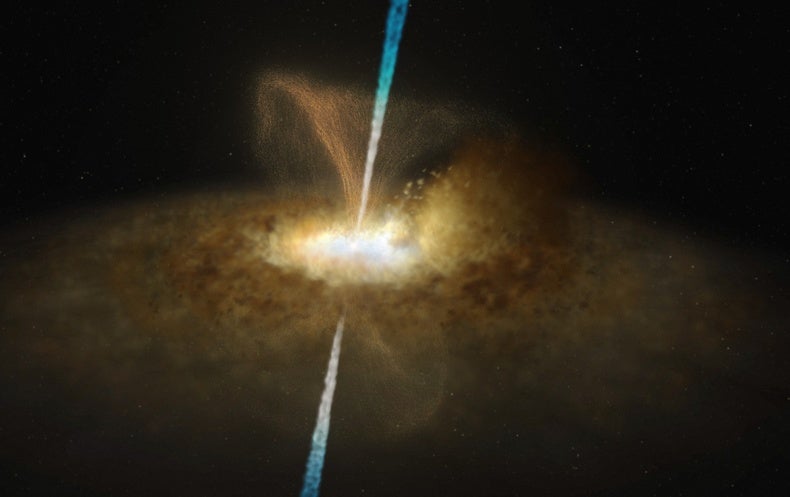Most American launch sites are on the coast. (Think Cape Canaveral.) But have you ever wondered why, for more than a decade, spacecraft returned to water, too?
Splashdown, the term for landing capsules or other spacecraft in a body of water with the help of parachutes, was NASA’s preferred method prior to the invention of the Space Shuttle. Now, in the era following it, we may be revisiting splashdowns as the best way to get astronauts home safely.
Here’s everything that entails.
Splashdown Mechanics: Aerobreaking
Upon reentry, spacecraft must slow down from an initial speed somewhere in the ballpark of 17,000 miles per hour to … well, a speed that the astronauts aboard could survive when hitting the planet’s surface.
Nowadays, by the time a space capsule actually splashes down in a body of water, it’s traveling at the relatively leisurely speed of around 15 to 20 mph. To begin slowing things down, NASA turns to a technique called aerobraking. Basically, the spacecraft purposely brushes against the top of Earth’s atmosphere just enough to create friction.
The giant parachutes you may already associate with splashdowns don’t actually come into play until the final leg of the flight — when the craft is less than 10,000 feet from the surface. If these are deployed too high up in the atmosphere, the thinner air poses problems.
On early Mercury flights, after a successful plunge into the ocean, a helicopter would then attach a cable to the capsule and place it safe and sound on a nearby ship. Later on, capsules came equipped with a flotation collar; this helped to prevent their sinking while waiting for a crane to hoist the craft and crew aboard.
The recovery ship for the Apollo 13 mission hoists the Command Module aboard ship in 1970. (Credit: NASA/Public Domain)
Read More: How the Heat of Reentry Helps Spacecrafts Return to Earth
Pros of Splashdowns
All American space capsules prior to the reusable Space Shuttle — which landed on runways like a commercial airplane — opted for a splashdown rather than a dry landing.
On the one hand, this made sense: Because launch sites are coastal, space capsules were already designed to survive a watery crash landing in the case of an emergency during launch.
Additionally, water makes for a much softer landing pad than … well, land. Parachutes alone wouldn’t have been enough; while Russian and Chinese crewed space capsules used heavy braking rockets to slow their final descents and return to dry ground, NASA wanted to avoid all that extra weight.
And, of course, if you’re landing in the ocean and find that your calculations are off by a few miles — no worries. Plenty of wiggle room there.
It’s a much different story on the continental U.S., which is riddled with canyons, towns and reservations even in the most remote deserts.
Cons of Splashdowns
On the down side, an empty, open ocean comes with problems of its own. At one point, locating and securing capsules after splashdown required the coordinated efforts of multiple Navy ships — not to mention millions of dollars.
In 1962, for example, the Aurora 7 overshot the planned landing zone by a whopping 250 miles. Astronaut Scott Carpenter waited three hours in a life raft before, drenched but happy, an HSS-2 helicopter scooped him up.
Even when the landing location goes right, other things can still go amiss.
Both the Skylab 4 mission and Apollo-Soyuz Test Project ended with capsized space capsules. Though inflatable “righting spheres” eventually righted the face-down Apollo-Soyuz capsule, crew member Vance Brand actually passed out before then.
Perhaps the most dangerous aspect of splashdowns, however, is the potential for flooding — and sinking. This was illustrated in 1961, when the hatch of Liberty Bell 7 mysteriously blew prematurely and almost caused the drowning of astronaut Gus Grissom.
The capsule itself, a grim reminder of the event, remained beneath the Atlantic Ocean for 38 years.
Read More: The Biggest Space Missions to Look For in 2023
NASA Splashdowns Today
The Orion spacecraft splashed down in the Pacific Ocean on Dec. 11, 2022. (Credit: NASA/Kim Shiflett)
The modern era of splashdowns was ushered in by SpaceX — and, thankfully, today’s landings, such as the Orion splashdown, have proved far less risky than their predecessors.
On Aug. 2, 2020, two NASA pilots rode the SpaceX Dragon capsule back to Earth, landing about 40 miles off the coast of Pensacola, Florida. This marked the first splashdown for NASA astronauts since the Apollo-Soyuz Test Project 45 years prior; it was also the first ever splashdown of a crewed spacecraft in the Gulf of Mexico.
Orion Splashdown
The uncrewed Orion splashdown, the finale of the Artemis I flight test, was also a great success in late 2022. After a 25-day trip around the moon, the Orion capsule hit Earth’s atmosphere at a speed of nearly 25,000 mph and at scorching temperatures near 5,000 degrees Fahrenheit — about half as hot as the surface of the sun, according to NASA.
Using a new maneuver called a “skip entry,” however, in which the capsule entered the upper part of Earth’s atmosphere not once but twice, the parachute-clad Orion coasted to the Pacific Ocean at a remarkable speed of 20 mph.
Now, the preparation for Artemis II is well underway. The mission aims to put humans on the moon for the first time since 1972 — and bring them back home with a splash. In February of this year, a recovery team that included NASA divers began training to recover the Orion capsule from water once again.
Read More: Neil deGrasse Tyson Responds to Artemis 2 Announcement














